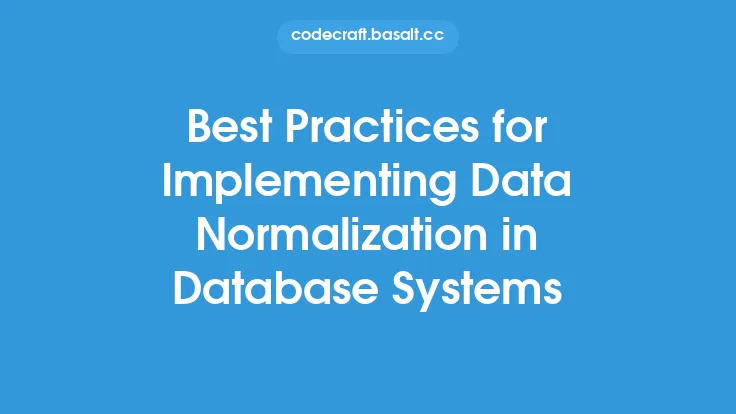Normalizing data in database systems is a crucial process that involves organizing and structuring data to minimize data redundancy and dependency. The goal of data normalization is to ensure that each piece of data is stored in one place and one place only, making it easier to maintain and update. In this article, we will provide a step-by-step guide on how to normalize data in database systems.
Introduction to Data Normalization
Data normalization is a process that involves applying a set of rules to a database to ensure that the data is consistent and reliable. The process involves dividing large tables into smaller tables and linking them through relationships. This helps to eliminate data redundancy and improves data integrity. Data normalization also helps to improve scalability, flexibility, and performance of the database.
Understanding the Normalization Process
The normalization process involves several steps, including:
- First Normal Form (1NF): This involves eliminating repeating groups and arrays by creating separate tables for each group.
- Second Normal Form (2NF): This involves eliminating partial dependencies by creating separate tables for each non-key attribute.
- Third Normal Form (3NF): This involves eliminating transitive dependencies by creating separate tables for each non-key attribute that depends on another non-key attribute.
Each step of the normalization process helps to eliminate data redundancy and improve data integrity.
Preparing for Data Normalization
Before starting the data normalization process, it is essential to prepare the database by:
- Identifying the entities: Identify the entities that will be used in the database, such as customers, orders, and products.
- Defining the attributes: Define the attributes for each entity, such as customer name, order date, and product description.
- Determining the relationships: Determine the relationships between the entities, such as a customer can have many orders, and an order is related to one customer.
- Creating a conceptual model: Create a conceptual model of the database, including the entities, attributes, and relationships.
Normalizing the Data
Once the database is prepared, the data normalization process can begin. This involves:
- Creating tables: Create separate tables for each entity, with each table having a primary key.
- Defining relationships: Define the relationships between the tables, using foreign keys to link the tables.
- Eliminating data redundancy: Eliminate data redundancy by ensuring that each piece of data is stored in one place and one place only.
- Ensuring data integrity: Ensure data integrity by using constraints, such as primary keys and foreign keys, to enforce the relationships between the tables.
Implementing Data Normalization
Implementing data normalization involves:
- Creating a physical model: Create a physical model of the database, including the tables, relationships, and constraints.
- Writing SQL code: Write SQL code to create the tables, relationships, and constraints.
- Populating the database: Populate the database with data, ensuring that the data is consistent and reliable.
- Testing the database: Test the database to ensure that it is functioning correctly and that the data is accurate and reliable.
Maintaining a Normalized Database
Maintaining a normalized database involves:
- Updating the database: Update the database regularly to ensure that the data is consistent and reliable.
- Monitoring performance: Monitor the performance of the database to ensure that it is functioning correctly.
- Optimizing the database: Optimize the database regularly to improve performance and scalability.
- Backing up the database: Back up the database regularly to ensure that the data is safe and secure.
Common Challenges and Solutions
Common challenges that may arise during the data normalization process include:
- Data inconsistencies: Data inconsistencies can occur when the data is not consistent across the database.
- Data redundancy: Data redundancy can occur when the same data is stored in multiple places.
- Performance issues: Performance issues can occur when the database is not optimized correctly.
Solutions to these challenges include:
- Using constraints: Using constraints, such as primary keys and foreign keys, to enforce data integrity.
- Optimizing the database: Optimizing the database regularly to improve performance and scalability.
- Monitoring performance: Monitoring performance regularly to identify and resolve any issues.
Best Practices for Data Normalization
Best practices for data normalization include:
- Following the normalization rules: Following the normalization rules, such as 1NF, 2NF, and 3NF, to ensure that the data is consistent and reliable.
- Using constraints: Using constraints, such as primary keys and foreign keys, to enforce data integrity.
- Optimizing the database: Optimizing the database regularly to improve performance and scalability.
- Monitoring performance: Monitoring performance regularly to identify and resolve any issues.
Conclusion
Data normalization is a crucial process that involves organizing and structuring data to minimize data redundancy and dependency. By following the steps outlined in this article, database administrators can ensure that their databases are normalized, consistent, and reliable. Remember to always follow best practices, such as using constraints and optimizing the database, to ensure that the database is functioning correctly and that the data is accurate and reliable.





